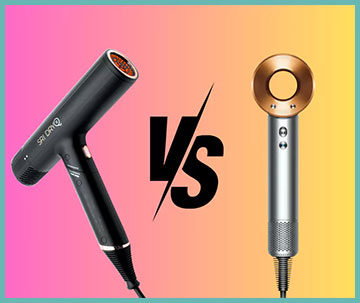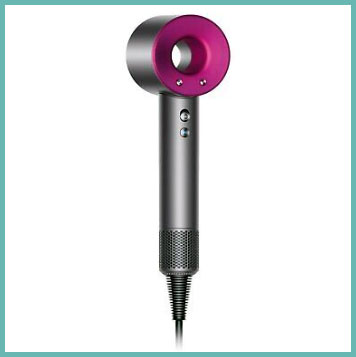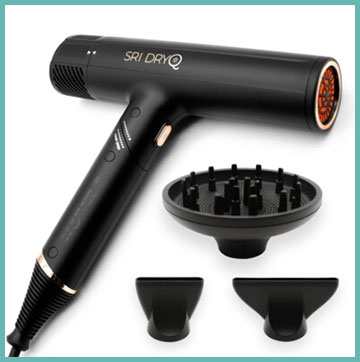I’ve spent years chasing the perfect blowout, wrestling with frizzy hair and clunky dryers that promise the world but deliver scorched ends.
So, when I heard about the SRI DryQ and Dyson Supersonic, I was intrigued. Both claim to revolutionize hair drying with cutting-edge tech and sleek designs, but which one truly delivers?
In this article, I’ll break down their key features, weigh their pros and cons, and share my experience as a real user to help you decide which dryer deserves a spot on your vanity.
Comparison Table: SRI Dryq Vs. Dyson Supersonic
| Feature | SRI DryQ | Dyson Supersonic |
| Price | ~$233 | ~$429 |
| Weight | 11.8 oz | 1.8 lbs (28.8 oz) |
| Wattage | 1300 W | 1600 W |
| Motor Speed | 100,000 rpm | 110,000 rpm |
| Heat Settings | 4 | 4 |
| Speed Settings | 3 | 3 |
| Attachments | 3 magnetic (diffuser, 2 concentrators) | 5 magnetic (diffuser, concentrator, flyaway, gentle air, wide-tooth comb) |
| Cord Length | 6.5 ft | 9 ft |
| Technology | Red light therapy, ionic, infrared | Ionic, Air Multiplier, intelligent heat control |
| Foldable Design | Yes | No |
| Warranty | 1-year, 60-day money-back guarantee | 2-year |
| Noise Level | 79 dB | ~77 dB |
My Journey With Hair Dryers
I’ve always been a bit of a hair tool skeptic. Growing up, I used whatever cheap dryer was lying around, often leaving my hair frizzy or flat. As I got older, I realized a good hair dryer could make or break my routine. My hair—thick, wavy, and prone to frizz—needs a tool that dries quickly without turning my strands into straw. That’s why I decided to test the SRI DryQ and Dyson Supersonic, two heavyweights in the premium hair dryer market. I wanted to see if they lived up to the hype and, more importantly, which one suited my hair best.
Unpacking the SRI DryQ

The moment I opened the SRI DryQ box, I was struck by how light it felt. At just 11.8 ounces, it’s like holding a feather compared to the bulky dryers of my past. The foldable design was a pleasant surprise—perfect for my cramped bathroom drawer and travel bag. It comes with three magnetic attachments: a diffuser for my wavy days and two concentrators for sleek styles. The red light therapy feature piqued my curiosity, promising to strengthen hair and reduce frizz. I was eager to see if this tech lived up to its claims.
The DryQ operates at 1300 watts with a motor spinning at 100,000 rpm, which sounded impressive but left me wondering how it stacked up against Dyson’s higher-powered motor. It has four heat settings and three speed settings, plus a cool shot button to lock in styles. The 6.5-foot cord felt a bit short for my liking, but the quiet 79-decibel operation meant I could dry my hair without waking the whole house.
Exploring the Dyson Supersonic
The Dyson Supersonic arrived with a reputation as the gold standard of hair dryers. Its sleek, futuristic design screamed luxury, but at 1.8 pounds, it felt noticeably heavier than the DryQ. The motor, housed in the handle, spins at 110,000 rpm and pushes 1600 watts, promising lightning-fast drying. It boasts five magnetic attachments: a diffuser, styling concentrator, flyaway attachment, gentle air attachment, and wide-tooth comb, catering to every hair type imaginable.
Dyson’s Air Multiplier technology and intelligent heat control, which measures air temperature 40 times per second, aim to minimize heat damage. The 9-foot cord gave me plenty of room to maneuver, but the bulky power brick was a hassle to store. At around 77 decibels, it’s slightly quieter than the DryQ, though not by much. I was excited to test its versatility but wary of the $429 price tag—could it really be worth it?
Key Features Face-Off
Let’s break down the standout features of each dryer, based on my hands-on experience and research.
SRI DryQ Features

The DryQ’s red light therapy is its secret weapon. This tech, rarely found in hair dryers, claims to stimulate hair follicles and improve scalp health, potentially strengthening hair over time. I noticed my hair felt softer after a few uses, though I can’t confirm long-term benefits without months of testing. The ionic technology worked wonders on my frizz, leaving my waves smooth and defined. The infrared heating and ceramic-tourmaline air outlet ensured even heat distribution, preventing the hot spots that used to fry my ends.
The foldable design was a game-changer for travel. I tossed it into my carry-on for a weekend trip, and it barely took up space. The intelligent heat control automatically adjusts temperature to avoid overheating, which gave me peace of mind. The memory function was a nice touch, letting me save my go-to settings for quick styling. At $233, it felt like a steal compared to Dyson, but the shorter cord and lack of dual-voltage were minor drawbacks for international travel.
Dyson Supersonic Features
Dyson’s Supersonic is a tech marvel. The V9 digital motor, paired with Air Multiplier technology, creates a powerful, controlled airflow that dried my hair in about 8 minutes—slightly faster than the DryQ’s 10. The intelligent heat control kept my scalp comfortable, never feeling like it was burning. The five attachments were a highlight, especially the flyaway attachment, which tamed stray hairs for a polished look. The magnetic connections made switching attachments a breeze, though I found myself rarely using the wide-tooth comb.
The ergonomic handle, with the motor inside, balanced the weight better than traditional dryers, but it still felt heavier than the DryQ during long sessions. The 9-foot cord was a blessing in my small bathroom, where outlets are awkwardly placed. However, the bulky cord and power brick were a pain to wrangle, and the $429 price felt like a splurge that needed to justify itself.
Pros and Cons: SRI DryQ
Pros
- Lightweight and Portable: At 11.8 ounces and foldable, it’s ideal for travel and small spaces.
- Red Light Therapy: A unique feature that may improve hair health over time.
- Affordable Price: At $233, it offers premium features without breaking the bank.
- Frizz Reduction: Ionic technology and infrared heating left my hair smooth and shiny.
- Quiet Operation: At 79 decibels, it’s gentle on the ears.
- Warranty and Guarantee: A 1-year warranty and 60-day money-back guarantee add peace of mind.
Cons
- Shorter Cord: The 6.5-foot cord limits mobility compared to Dyson’s 9 feet.
- Fewer Attachments: Only three attachments, missing Dyson’s flyaway and wide-tooth comb options.
- No Dual-Voltage: Not ideal for international travel without a converter.
- Button Placement: Controls can be tricky to reach mid-styling.
Pros and Cons: Dyson Supersonic
Pros
- Powerful Performance: The 1600-watt motor and Air Multiplier technology dry hair quickly.
- Versatile Attachments: Five magnetic attachments cater to all hair types and styles.
- Heat Protection: Intelligent heat control prevents damage, ideal for frequent stylers.
- Long Cord: The 9-foot cord offers flexibility in tight spaces.
- Sleek Design: It’s a status symbol that looks as good as it performs.
- Durability: A 2-year warranty suggests confidence in longevity.
Cons
- Expensive: At $429, it’s a significant investment.
- Heavy: At 1.8 pounds, it’s less comfortable for long sessions.
- Bulky Cord: The power brick makes storage and travel cumbersome.
- Learning Curve: The powerful airflow can tangle hair if not used carefully.
Read More: My Thoughts On Adagio Blowout Brush
My Testing Experience
I put both dryers through their paces over two weeks, styling my thick, wavy hair daily. I alternated between rough-drying for volume and using attachments for sleek blowouts or defined curls. Here’s how they performed in real life.
Drying Speed and Efficiency
The Dyson edged out the DryQ in drying speed, taking about 8 minutes to dry my shoulder-length hair compared to the DryQ’s 10. However, the difference wasn’t dramatic enough to justify Dyson’s price alone. Both dryers felt powerful, but the DryQ’s infrared technology made the process gentler on my scalp. I noticed less dryness with the DryQ, especially after multiple uses in a week.

Ease of Use
The DryQ’s lightweight design was a clear winner for me. Holding it for 10 minutes didn’t tire my arm, unlike the Dyson, which started to feel heavy after 5 minutes. The DryQ’s foldable handle made storage a breeze, while the Dyson’s bulky cord was a constant annoyance. However, Dyson’s magnetic attachments were easier to swap mid-styling, and the longer cord gave me more freedom to move.
Hair Health and Styling Results
Both dryers delivered smooth, shiny results, but the DryQ’s red light therapy and ionic tech gave it a slight edge for frizz control. My waves looked more defined and less poofy with the DryQ’s diffuser. The Dyson’s flyaway attachment was a lifesaver for polishing my blowouts, but I didn’t notice a significant difference in hair health compared to the DryQ. Both protected my hair from heat damage, but the DryQ felt gentler overall.
Noise and Comfort
The DryQ’s 79-decibel hum was quieter than I expected for a high-powered dryer, letting me listen to music while styling. The Dyson, at 77 decibels, was marginally quieter but not enough to notice in practice. Both were a vast improvement over my old, roaring Conair.
Who Are These Dryers For?
The SRI DryQ is perfect for budget-conscious users who want premium features without the luxury price tag. Its lightweight, foldable design makes it ideal for travelers or those with small spaces. If you have frizzy or damaged hair, the red light therapy and ionic tech are tailored to your needs. It’s also great for daily use, as the low weight reduces arm fatigue.
The Dyson Supersonic is for those who prioritize versatility and don’t mind splurging. Its five attachments make it a one-stop shop for all hair types, from fine to coily. If you style your hair often or need specific attachments like the flyaway smoother, Dyson’s worth considering. It’s also a status symbol for those who love high-end gadgets.
Price vs. Value
At $233, the DryQ feels like a smart investment. It delivers 90% of Dyson’s performance at half the cost, with unique features like red light therapy that Dyson lacks. The Dyson’s $429 price is harder to swallow, especially since it didn’t outperform the DryQ significantly in my tests. Unless you need the extra attachments or crave the Dyson brand, the DryQ offers better value.
Real-World Scenarios
I imagined a few scenarios to see which dryer suits different lifestyles:
- The Frequent Traveler: The DryQ’s foldable design and light weight make it a no-brainer for packing. Dyson’s bulkier build and non-foldable structure are less practical.
- The Busy Professional: Dyson’s faster drying time shaves off a minute or two, but the DryQ’s memory function streamlines your routine.
- The Curly-Haired Stylist: Both dryers’ diffusers worked well, but Dyson’s wide-tooth comb is a bonus for coily hair. The DryQ’s frizz control was slightly better for my waves.
- The Budget Shopper: The DryQ wins hands-down for its price-to-performance ratio.
What the Experts Say
I dug into reviews from hairstylists and beauty editors to round out my perspective. Many praise the Dyson for its versatility and fast drying, with some calling it a “game-changer” for professional use. However, others noted its weight and price as drawbacks, especially compared to newer models like the DryQ. The DryQ’s red light therapy and affordability earned high marks, with testers loving its smooth, frizz-free results. Some stylists felt Dyson’s attachments were overkill for casual users, while the DryQ’s simplicity appealed to beginners.
My Final Verdict
After weeks of testing, I’m Team DryQ. Its lightweight design, frizz-busting tech, and wallet-friendly price make it a standout. The Dyson is impressive, no doubt, with its powerful motor and versatile attachments, but it didn’t transform my hair enough to justify the cost. For most people, the DryQ delivers salon-quality results without the luxury markup. You’ll get smooth, shiny hair and a tool that’s easy to use and store, all while saving a chunk of change.
Read More: My Thoughts On Drybar Buttercup Vs. Dyson Supersonic
Frequently Asked Questions (FAQ)
The SRI DryQ is the closest match, offering similar ionic technology, fast drying, and magnetic attachments at a lower price.
Aldi occasionally sells a budget-friendly hair dryer under its Ambiano brand, mimicking Dyson’s design but lacking advanced tech like ionic or heat control features.
The SRI DryQ takes the crown for its balance of affordability, lightweight design, and frizz-reducing tech, though Dyson excels for versatility.
SRI hair dryers are made by the Skin Research Institute, a U.S.-based, BBB-accredited company focused on effective, safe beauty tools.
Conclusion
You’ve got a choice to make: splurge on the Dyson Supersonic for its flashy design and extra attachments, or go for the SRI DryQ’s practical, hair-healthy features at a fraction of the price. My experience showed the DryQ delivers where it counts—smooth, frizz-free hair without the arm ache or wallet pain. Whichever you pick, you’re investing in better hair days. Trust your needs, weigh the pros and cons, and choose the dryer that fits your life. Your perfect blowout is waiting.
